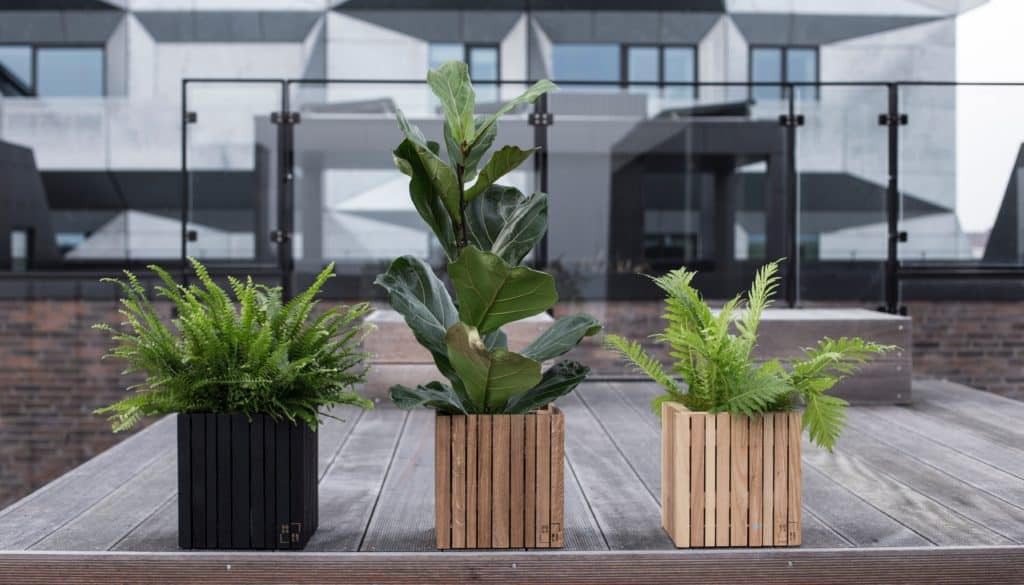Around here, we’re big fans of ficus lyrata, or fiddle leaf fig. But did you know there are lots of other ficus or fig tree houseplants you can grow inside?
We’ve written about a few of them here (check out our articles on Ficus Audrey and Ficus Benjamina), but we wanted to show you a few other options for gorgeous indoor fig trees. They vary a bit in appearance, but care requirements are pretty similar. They can look gorgeous when paired with your fiddle leaf fig tree or other houseplants!
Some fig trees can grow to massive sizes in the wild while others stay relatively small. Some produce fruit (like ficus carica, which produces the figs you can buy in the grocery store), while others don’t or rarely fruit inside. Some ficus trees are better suited to life as a houseplant than others.
Let’s look at some fig tree houseplants that are simple to grow inside and tips for caring for each.
How to Grow Fig Tree Houseplants
Ficus Pandurata (AKA fiddle leaf fig)
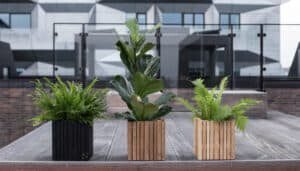
This one is confusing, but our beloved ficus lyrata/fiddle leaf fig actually goes by another name: ficus pandurata.
This site is full of tips and products for taking excellent care of your ficus lyrata, FLF, ficus pandurata, or whatever you want to call it.
Ficus Elastica
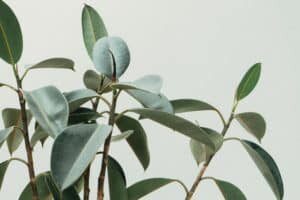
The ficus elastica, or rubber tree, is a super popular houseplant that you probably see all the time. This plant is easy to find in home improvement stores and nurseries, so it’s a great one to add to your collection.
The sap of this tree was once used to produce rubber, so the name isn’t just for fun! It’s very popular for its large, dark green, oblong leaves. Care is also very similar to a fiddle leaf fig with the same light, drainage, water, and fertilizer needs. If you can take care of ficus lyrata, you’ll love ficus elastica!
Ficus Microcarpa
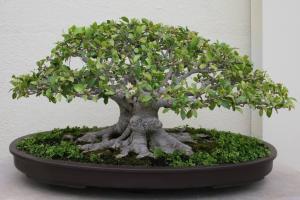
This is a small variety of ficus that makes a fantastic bonsai tree for beginners. It also goes by the names ficus bonsai and Chinese banyan tree. It can reach up to 40 inches indoors and looks like a scaled-down version of a larger tree with a small leaves, a thick, knobby trunk, and aerial roots that reach down to the ground.
This tree loves humidity, indirect sunlight, and excellent drainage, much like the fiddle leaf fig. Basically, it will be happy in bright, indirect sunlight and likes to be watered when the top inch of soil is dry. Make sure your pot and soil drain well.
Ficus microcarpa also requires yearly repotting and must be pruned regularly to help it maintain its shape. Since it’s such a small tree when grown as a bonsai, any stray twigs or branches can make it look lopsided!
Out of every 10 new leaves, you can safely cut away about 4-6 of them. Rotate the plant regularly and avoid pruning when it’s not growing new leaves. Trim away any growth or aerial roots from the trunk that you don’t like. Be sure to use sharp pruning shears like these when cutting.
Ficus Benghalensis

Also called Ficus Audrey or banyan tree, this plant can get MASSIVE in the wild but maintains a manageable size indoors. It’s similar to the fiddle but with slightly smaller leaves. It’s also known for being a bit more flexible with its light and water needs.
Like ficus microcarpa, this plant puts down aerial roots, so you may want to trim those from time to time. Otherwise, care is similar to that of a fiddle leaf fig. Place in bright, indirect sunlight. Use a pot with drainage holes and well-aerated soil. Water when the top few inches are dry and fertilize in the spring and summer. (Fiddle Leaf Fig Food is perfect for this.)
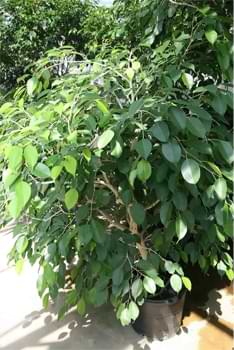
Also known as the weeping fig, this is the most popular indoor ficus. With small, almond-shaped leaves that point downward, Ficus Benjamina looks quite different from fiddles. These trees were hugely popular a few decades ago, and they’re coming back into style!
You can braid the trunks together and even grow it as a bonsai! It will usually stay within 3-6 feet tall indoors.
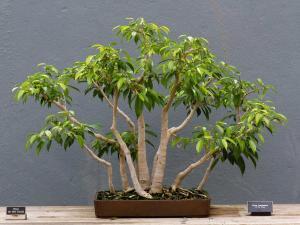
To care for the weeping fig, fiddle leaf fig rules work beautifully. However, these plants definitely don’t do well in cold conditions and will drop their leaves in a draft, so be extra careful to keep your home above 70 degrees Fahrenheit and water with lukewarm or room-temperature water.
Ficus Pumila
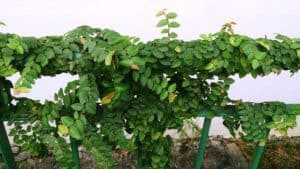
This ficus is also called creeping fig because it’s actually a creeping vine rather than a tree like its other ficus friends.
This plant does well as ground cover in another pot or in terrariums or topiaries. This means you’ll want to provide it with a trellis or something to climb.
Repot annually and/or prune the roots and branches to keep it to a manageable size. The plant will start to die off when it outgrows its pot, which means you can keep pruning and/or propagate so you have a new plant ready to go when the main one gets too large and starts to decline in its confined space.
Light, soil, water, humidity, and fertilizer needs are the same as that of a fiddle leaf fig. To propagate, simply take a cutting with a node, dip in a rooting hormone like Houseplant Propagation Promoter, and plant in fresh soil. (To read our Fiddle Leaf Fig Propagation Tips, click here and scroll down a bit.)
About our new Houseplant Propagation Promoter
The exclusive formula of Houseplant Propagation Promoter helps support strong growth and photosynthesis, and it protects new cuttings against bacteria and toxins that can cause new cuttings to fail. With this easy-to-use product, you will be able to clone your best plants more quickly, even tough-to-propagate species like fiddle leaf figs. It also comes with a free Complete Propagation Guide, which includes photos and step-by-step instructions. Click here to buy now.
Fig tree houseplants are similar
The good news is that if you can care for a fiddle leaf fig, you’ll do just fine with any other type of ficus because the care is so similar.
All of these ficus trees have the same preferences:
- Warm temperatures above 70 degrees if possible
- Humidity above 60 percent when possible
- Moderate water (water when the two 1-3 inches of soil is dry)
- Well-draining soil and pot
- Bright, indirect sunlight
- Regular fertilizing with a 3-1-2 liquid fertilizer
On top of that, these are the preferred conditions of most tropical houseplants! Ficuses are great for honing your green thumb, and they all make striking, statement-making indoor trees. You won’t be able to stop with just one.
Grab the Essentials for Your Houseplants:
- Premium Fiddle Leaf Fig Potting Soil
- Fiddle Leaf Fig Plant Food
- Root Rot Treatment
- Houseplant Leaf Armor to protect against insects, bacteria, and fungus (As an added bonus, it also cleans and adds shine to your plant’s leaves!)
- Moisture meter to always know when your plant is thirsty.
- Houseplant Propagation Promoter to propagate more quickly and with more success.
To learn more:
- Sign up for our free Fiddle Leaf Fig Care 101 Webinar or enroll in our free Fiddle Leaf Fig Course for advanced fiddle leaf fig care.
- Make sure you’re subscribed to our newsletter.
- Read The Fiddle Leaf Fig Expert, your complete guide to growing healthy fiddle leaf fig plants. The book is available in full-color paperback or Kindle edition on Amazon now!
- Click to join our community on Facebook: Fiddle Leaf Fig Plant Resource Group.

